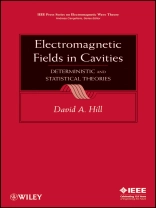A thorough and rigorous analysis of electromagnetic fields in
cavities
This book offers a comprehensive analysis of electromagnetic
fields in cavities of general shapes and properties.
Part One covers classical deterministic methods to
conclude resonant frequencies, modal fields, and cavity losses;
quality factor; mode bandwidth; and the excitation of cavity fields
from arbitrary current distributions for metal-wall cavities of
simple shape.
Part Two covers modern statistical methods to analyze
electrically large cavities of complex shapes and properties.
Electromagnetic Fields in Cavities combines rigorous
solutions to Maxwell’s equations with conservation of energy to
solve for the statistics of many quantities of interest:
penetration into cavities (and shielding effectiveness), field
strengths far from and close to cavity walls, and power received by
antennas within cavities. It includes all modes and shows you how
to utilize fairly simple statistical formulae to apply to your
particular problem, whether it’s interference calculations,
electromagnetic compatibility testing in reverberation chambers,
measurement of shielding materials using multiple cavities, or
efficiency of test antennas. Electromagnetic Fields in
Cavities is a valuable resource for researchers, engineers,
professors, and graduate students in electrical engineering.
Содержание
PREFACE.
PART I. DETERMINISTIC THEORY.
1. Introduction.
1.1 Maxwell’s Equations.
1.2 Empty Cavity Modes.
1.3 Wall Losses.
1.4 Cavity Excitation.
1.5 Perturbation Theories.
Problems.
2. Rectangular Cavity.
2.1 Resonant Modes.
2.2 Wall Losses and Cavity Q.
2.3 Dyadic Green’s Functions.
Problems.
3. Circular Cylindrical Cavity.
3.1 Resonant Modes.
3.2 Wall Losses and Cavity Q.
3.3 Dyadic Green’s Functions.
Problems.
4. Spherical Cavity.
4.1 Resonant Modes.
4.2 Wall Losses and Cavity Q.
4.3 Dyadic Green’s Functions.
4.4 Schumann Resonances in the Earth-Ionosphere Cavity.
Problems.
PART II. STATISTICAL THEORIES FOR ELECTRICALLY LARGE
CAVITIES.
5. Motivation for Statistical Approaches.
5.1 Lack of Detailed Information.
5.2 Sensitivity of Fields to Cavity Geometry and Excitation.
5.3 Interpretation of Results.
Problems.
6. Probability Fundamentals.
6.1 Introduction.
6.2 Probability Density Function.
6.3 Common Probability Density Functions.
6.4 Cumulative Distribution Function.
6.5 Methods for Determining Probability Density Functions.
Problems.
7. Reverberation Chambers.
7.1 Plane-Wave Integral Representation of Fields.
7.2 Ideal Statistical Properties of Electric and Magnetic
Fields.
7.3 Probability Density Functions for the Fields.
7.4 Spatial Correlation Functions of Fields and Energy
Density.
7.5 Antenna or Test-Object Response.
7.6 Loss Mechanisms and Chamber Q.
7.7 Reciprocity and Radiated Emissions.
7.8 Boundary Fields.
7.9 Enhanced Backscatter at the Transmitting Antenna.
Problems.
8. Aperture Excitation of Electrically Large, Lossy
Cavities.
8.1 Aperture Excitation.
8.2 Power Balance.
8.3 Experimental Results for SE.
Problems.
9. Extensions to the Uniform-Field Model.
9.1 Frequency Stirring.
9.2 Unstirred Energy.
9.3 Alternative Probability Density Function.
Problems.
10. Further Applications of Reverberation Chambers.
10.1 Nested Chambers for Shielding Effectiveness
Measurements.
10.2 Evaluation of Shielded Enclosures.
10.3 Measurement of Antenna Efficiency.
10.4 Measurement of Absorption Cross Section.
Problems.
11. Indoor Wireless Propagation.
11.1 General Considerations.
11.2 Path Loss Models.
11.3 Temporal Characteristics.
11.4 Angle of Arrival.
11.5 Reverberation Chamber Simulation.
Problems.
APPENDIX A. VECTOR ANALYSIS.
APPENDIX B. ASSOCIATED LEGENDRE FUNCTIONS.
APPENDIX C. SPHERICAL BESSEL FUNCTIONS.
APPENDIX D. THE ROLE OF CHAOS IN CAVITY FIELDS.
APPENDIX E. SHORT ELECTRIC DIPOLE RESPONSE.
APPENDIX F. SMALL LOOP ANTENNA RESPONSE.
APPENDIX G. RAY THEORY FOR CHAMBER ANALYSIS.
APPENDIX H. ABSORPTION BY A HOMOGENEOUS SPHERE.
APPENDIX I. TRANSMISSION CROSS SECTION OF A SMALL CIRCULAR
APERTURE.
APPENDIX J. SCALING.
REFERENCES.
INDEX.
Об авторе
David A. Hill is a Guest Researcher at the National Institute of Standards and Technology (NIST) specializing in cavity theory and reverberation chamber applications. Previously, he held project leader positions with the Institute for Telecommunication Sciences and NIST. Since 1980, he has been an Adjunct Professor in the Department of Electrical and Computer Engineering at the University of Colorado at Boulder, where he teaches graduate courses in electromagnetics and advises graduate students on master’s and Ph D theses. Dr. Hill is an IEEE Life Fellow and a member of URSI Commissions A, B, E, and F. He has won IEEE EMC Society Prize Paper Awards for ‘Out-of-Band Response of Antenna Arrays’ in 1987 and ‘On Determining the Maximum Emissions from Electrically Large Sources’ in 2002.












